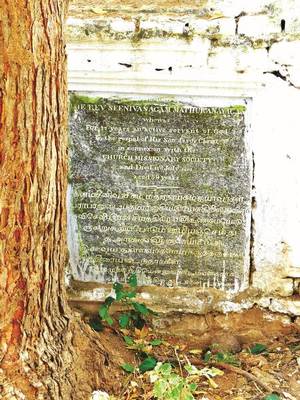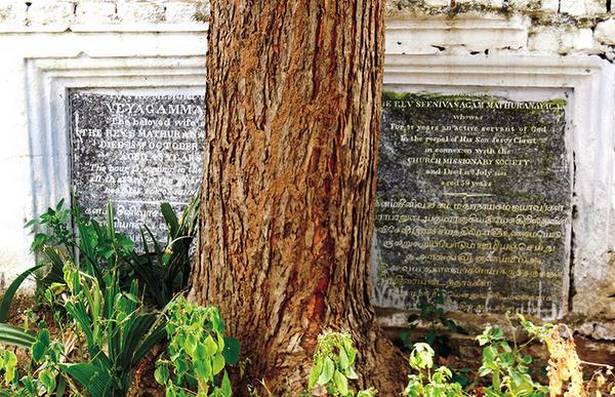Dr Samuel Vasundaran who is determined to prove his family’s links with Yusuf Khan (Miscellany, March 5) aka Maruthanayagam Pillai spent a morning with me recently telling me a fascinating story. He’d heard it from his paternal grandmother, Alice Samuel Mathuranayagam Pillai in 1981 and had been following the trail ever since.
As a starting point, she pointed him to two tombs in the Adaikalapuram cemetery near the family home in Palayamkottai. The pictures he sent me show today the tomb of Veyagammal (died 1858) and, partly hidden, that of her husband the Rev Srinivasagam Mathuranayagam (the inscription shown better in the second picture). Born in 1802, the Reverend was trained by ‘The Apostle of Tinnevelly’, the Rev CTF Rhenius, and served in the area till his death in 1861.
From Dr Vasundaran’s point of view, the Rev. is his father’s great grandfather but from Alice Paati’s view he was the grandson of Yusuf Khan! And in trying to follow that trail, Dr Vasundaran had found some intriguing – but not definitive – information.
Apparently, a boy called Mathuranayagam, said to be the adopted son of Yusuf Khan’s Dewan, Srinivasa Rao, a Vaishnavite Brahmin of Tanjore, was christened Samuel one day in 1778 according to the Palayamkottai Church records. Baptised by Schwartz on the same day at the same place was the legendary Clarinda (Miscellany, December 18, 2017) and Vedanayagam Sastriar (Miscellany 22, 2009). Intriguingly, the same records show a Brahmin woman baptised on the same day. But her name has been erased. She, the legend goes, was the mother of Yusuf Khan’s son whom Srinivasa Rao adopted after the death of the Khan Sahib. Yusuf Khan’s wife has been well recorded as Maza (possibly Marcia), a Luso-Indian. Did she become a Hindu when she sought Srinivasa Rao’s protection?
Now comes one more twist. Who this Samuel Mathuranayagam (Srinivasa Rao) married is not known, but he named his first son Srinivasagam, after Srinivasa Rao and the family have followed the practice to this day.
After a long morning’s conversation, neither Vasundaran nor I was able to convince each other about the antecedents of Yusuf Khan, but the roots from the Srinvasagam Mathuranayagam life have certainly been traced on solid ground.
Samuel Srinivasagam Pillai (1856-1909), for instance, better known as ML Pillai because he was the first person in the Tinnevelly District to have a Master of Law degree, was the grandson of Rev Srinivasagam Mathuranayagam. He was an eminent lawyer, much sought after by litigating Zamindars and land-owners. His fourth daughter, Thai Elizabeth, was Dr Chandran Devanesen’s mother and his fifth daughter, Kothai, was Manohar Devadoss’ maternal grandmother.
___________________________________
A 300-year-old spy story
Governor Joseph Collett (1717-20) is best remembered for his establishing Collettpetta that at some point in time got corrupted to Kaladipet (Miscellany, November 21, 2016). As intriguing as that story of his Head Clerk going to Kanchipuram every day to worship is the story of the spy Collett had to deal with in Fort St George. It was for the first time that, in February 1718, Collett informed the Board that he had held prisoner for some time one Francisco Ferera who claimed to be a doctor. Ferera was being held “a close prisoner” because he had been passing on Fort St George information to the Moors in the surrounding country.’
Typical of the times, Ferera was a multi-faceted personality. Or at least he claimed to be so. He had been a Jew in Italy, Constantinople and Grand Cairo. In Cairo he became a Turk (a Moor), married and had children there, settling down as a family. He is next heard of on the Coromandel Coast, claiming to be a Christian and married to a Portuguese woman who lived in Madras.
Collett offered the view that Ferera had been kept in captivity long enough, could do no more harm, and had many citizens appealing for his release. He proposed that the prisoner be freed on giving security for his behaviour and agreeing that he would not go out of the bounds of Madras without the permission of the Governor. The Board agreed with the Governor’s recommendation.
Francisco Gregorio, a resident of Madras, and referred to by the prisoner as, and known to be, a person of substance, offered to be “bound with him in the penal sum of 1,000 pagodas for his good behaviour”. Ferera was freed and vanishes into the mists of lesser history.
_____________________________________
When the postman knocked…
A quizzer wants to know how Beri Thimmappa, one of the founders of Madras, was connected with Guindy Lodge that has now grown into Raj Bhavan. It’s an indirect connection. His youngest brother Chinna Venkatadri was the dubash of Governor William Langhorne. Before leaving for England in January 1678, Langhorne sold Guindy Lodge and its environs to Chinna Venkatagri who, before long, had problems with the Company and had to virtually gift the property to the Government.
He also wants to know who was the only Chief Minister to occupy the official residence meant for the Chief Ministers of Tamil Nadu, Cooum House. T Prakasam. It later became for some years the official residence of the Speakers of the Legislative Assembly.
Sad, sad, sad. Even the 1930s Bosotto’s façade seen in a picture last week as bitten the dust.
The chronicler of Madras that is Chennai tells stories of people, places, and events from the years gone by, and sometimes, from today
source: http://www.thehindu.com / The Hindu / Home> Society> History & Culture / by S. Muthiah / April 02nd, 2018

